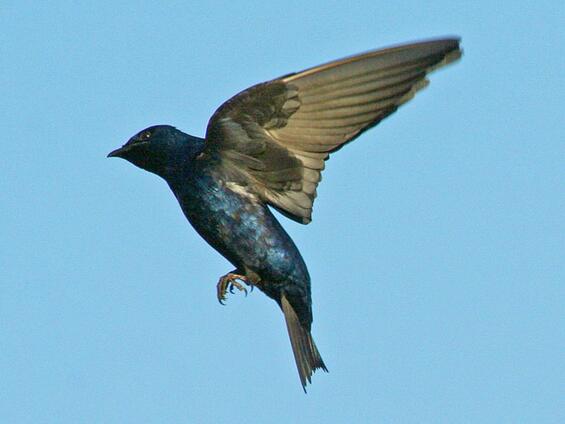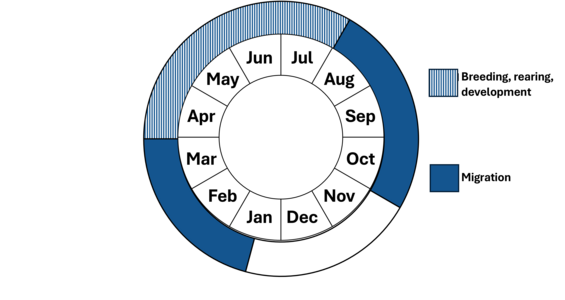- Scientific name: Progne subis
- Species of Greatest Conservation Need (MA State Wildlife Action Plan)
Description

The purple martin is the largest of the North American swallows. The adult male is a glossy blue-black color, and females are blue-black above and lighter gray-brown below. The female is further distinguished by a gray collar and forehead. Juveniles resemble the female with less blue-black above. Martins forage for insects on the wing, often at higher altitudes than other swallows. Purple martins are a cavity-nesting bird that often forms breeding colonies.
Life cycle and behavior

The purple martin’s breeding season begins in April when they return from their wintering grounds in South America. They nest almost exclusively in man-made birdhouses or gourds provided by people, especially in eastern North America. Purple Martins lay 3–7 white eggs in nests made of twigs, leaves, and mud, usually built in cavities or artificial structures. Females incubate the eggs for about 15–18 days, and the young fledge approximately 26–32 days after hatching. Fall migration typically begins in late July and continues through September as they make their way back to the Amazon Basin for the winter. Purple martins can migrate long distances relatively quickly, over 300 miles per day in some cases. Sometimes purple martins can complete their migration to South America in just 5 days, although other reports document this migration taking 3-6 weeks in other instances.
Population status
According to the Breeding Bird Survey (BBS), the purple martin has shown an increasing trend in Massachusetts, but a significant decreasing BBS trend in the eastern US region. This decline is due to factors such as competition for nesting sites with invasive species like European starlings and house sparrows, loss of natural nesting habitats, and widespread pesticide use reducing their insect prey.
Distribution and abundance
In Massachusetts, purple martens are primarily found along near the coast, but they have recently been documented along the Connecticut River valley where they historically nested. Purple martin breed from central Alberta southeastward through Ontario, southern Quebec, and northwest Nova Scotia, running south through the United States primarily east of the 102nd parallel and as far south as the Gulf Coast and southern Florida. They are also found in the mountains of New Mexico, southern and northwest Arizona, western Colorado, north central Utah, and along the eastern slopes of the Sierra Nevada Mountains of California and western Mexico. Populations are at risk in California due to human activity and competition with starlings. However, populations often rebound in areas where nesting structures are provided. Purple martins are a long-distance migrant with a large wintering range spanning 7 countries in South America including Bolivia and Brazil.
Habitat
Martins traditionally inhabited forest edge or beaver flowages where woodpeckers have bored holes into dead snags. Although purple martin can still be found using natural cavities in the western United States, in the east they are now dependent on human-maintained nesting structures like gourds or houses.
Healthy habitats are vital for supporting native wildlife and plants. Explore habitats and learn about conservation and restoration in Massachusetts.
Threats
Lack of adequate nest cavities, particularly in western North America, has resulted in a limited population size. In eastern North America, human-supplied nest sites seem to adequately supplement purple martin populations. That said, reliance on human intervention for nest sites creates a situation that is not ideal to sustain such a small and somewhat isolated population, particularly because nest boxes may be more quickly occupied by house sparrows and European starlings, thus requiring more rigorous human intervention. Several days of continuous cool wet weather can be particularly hard on martins and may result in high mortality rates that can eradicate entire colonies.
An additional threat to the species is collisions with buildings and other structures, as approximately 1 billion birds in the United States are estimated to die annually from building collisions. A high percentage of these collisions occur during the migratory periods when birds fly long distances between their wintering and breeding grounds.
Conservation
Conservation of purple martins should prioritize providing and maintaining suitable nesting sites as the purple martin is almost exclusively reliant on artificial nesting sites including multi-compartment nest houses and gourds. These structures should be placed in open areas away from trees, regularly monitored, and protected from invasive species like European starlings and house sparrows to promote successful breeding.
Bird collision mortalities can be minimized by making glass more visible to birds. This includes using bird-safe glass in new construction and retrofitting existing glass (e.g., screens, window decals) to make it bird-friendly and reducing artificial lighting around buildings (e.g., Lights Out Programs, utilizing down shielding lights) that attract birds during their nocturnal migration.
References
Brown, C. R., D. A. Airola, and S. Tarof (2021). Purple Martin (Progne subis), version 2.0. In Birds of the World (P. G. Rodewald, Editor). Cornell Lab of Ornithology, Ithaca, NY, USA. https://doi.org/10.2173/bow.purmar.02
Veit, R., and W.R. Petersen. Birds of Massachusetts. Lincoln, MA: Massachusetts Audubon Society, 1993.
Walsh, J., and W.R. Petersen. Massachusetts Breeding Bird Atlas 2. Massachusetts Audubon Society and Scott & Nix, Inc., 2013.
Connecticut Department of Energy and Environmental Protection. “Purple Martin.” 2021. CT.gov.
American Bird Conservancy. “Purple Martin.” 2023. ABC Birds.
Stutchbury, Bridget J. M., and Tim Morton. “Tracking Purple Martin Migration to Brazil, and Back!” 2009. Purple Martin Conservation Association.
Purple Martin Conservation Association. “Migration Timeline.” 2023. PurpleMartin.org.
Cornell Lab of Ornithology. “Purple Martin Life History.” 2023. All About Birds.
Contact
| Date published: | May 16, 2025 |
|---|